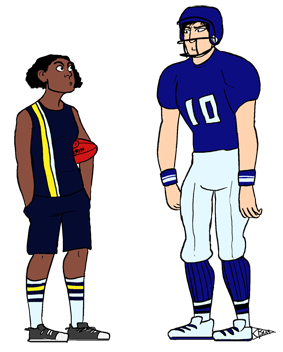VCE Task : Writing in context: (exploring themes)
 By now, you will be familiar with a text response essay, that is an expository/analytical essay focussing specifically on a text’s themes and characters.
By now, you will be familiar with a text response essay, that is an expository/analytical essay focussing specifically on a text’s themes and characters.
Let’s learn how to write “a hybrid” expository essay, that is, an expository essay with story-telling devices, somewhat like a feature or opinion style article. The essay will relate to a theme such as conflict, identity, justice, whose reality or imaginary landscapes. This style also shares similarities with personal/reflective pieces and is ideal to convey complex ideas and interesting examples that suit the criteria of Part B: Writing in Context. (See Writing Better Essays, Feature and Opinion Articles, pp. 65-71 published by English Works).
Basically, your essay will consist of a string of evidence, but the evidence you select and the way you organise and string your evidence together and link it to the prompt makes the difference. In other words, what connections are you making to your chosen text? How are you interpreting the evidence? What conclusions are you drawing from the evidence? What similarities are evident? What contrasts are evident? (See, Writing Better Essays, Evidence and reasoning strategies, pp. 20-30 and p. 61).
Firstly, let’s build your evidence. You need a collection of anecdotal and real-life stories as well as a sample of professional observations, quotes and remarks. We can also include examples of characters from other texts that you have studied in school.
1. Gathering your evidence: anecdotes, personal and professional observations and comments
- A personal anecdote should be relatable, dramatic, or colourful; it must consist of sharp, insightful and accurate descriptions. The story should be presented in such a way as to elicit an emotional response and perhaps even a humorous one. Most importantly, there must be a clear link to the prompt.
- A real-life story or anecdotal evidence draws upon people’s every-day and extraordinary experiences; it may draw upon articles or short stories you have read. It must be meaningful. You must capture as accurately as possible the protagonist’s (person-as-main-character’s) views, values, attitudes, responses, dilemmas and reactions.
- Expert or professional advice, research, quotes and surveys: again capture the main point, show relevance to the prompt and include quotes.
- See “Writing Anecdotes and Real-life examples“
2. Higher order reasoning skills:
- The next stage is to evaluate and interpret the evidence. What does it explain with regards to the prompt? What similarities are evident among the various examples? What are the differences? Are there any contradictions or unusual examples?
- Gather some quotes from well-known people or from poems or proverbs that reflect the point of the anecdote. Sometimes a quote is worth a whole paragraph.
3. Link the evidence to the prompt
- The next task is to select the best series of examples/evidence that shed light on the prompt.
- Some examples are more complicated than others. It is a good idea to start with the most obvious and straightforward example and then show a progression of ideas and thoughts, building to the more complex or those that show a contradiction or some ambiguity. Again your choice of evidence and organisation is critical to a clear, insightful and interesting essay.
- Consider how you can weave in some a few interesting quotes/concepts/poetic examples.
VCE TASK: spotlight on “Encountering Conflict”
Prompt specifications: causes — why and how conflict arises; think about the ways society is affected by conflict; how people react to it; how they respond to it, how they cope with it; what people say about it; how we resolve conflict.
Firstly, summarise a selection of people stories/professional comments. For example:
- Articles: “Fear of the world turned my son into a cyber addict”: family and personal conflict